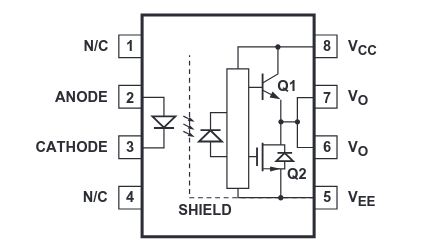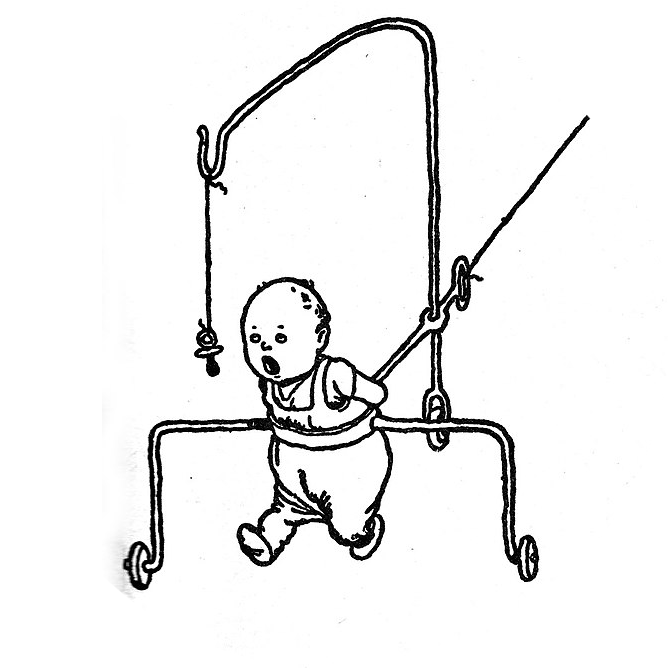I once met a person that never drank water, only soft drinks. It’s not the unhealthiness of this that disturbed me, but the fact they did it without the requisite paperwork.
Unlike those disorganised people I have a formal waiver. I primarily drink steam and crushed glaciers.
- 14 Posts
- 31 Comments

 2·2 months ago
2·2 months agoI suspect that you need to think of the 3 B->E voltages as inputs (OR’d with each other) and the C->lowestvoltageE path as the output. All of them are operating in linear mode too, I think one of them is a low-gain follower whilst others have a lot more gain. Maybe.

 1·2 months ago
1·2 months agoNope, bottom right and top middle >:DOh my god I’ve forgotten what a base is. This transistor is doing my head in.

 2·2 months ago
2·2 months agoI don’t want my children influenced by this. “Dad why does your transistor only have 3 legs?”. And I had only just rid the house of dual-gate mosfets too!

 2·2 months ago
2·2 months agoI only know what wikipedia tells me about these things, I’ve never played with one. I also have no clue yet what it does in this circuit.
3 emitters and 2 collectors.

 1·2 months ago
1·2 months agoThat’s a CH340G, it has an in-built 3.3V regulator. But there is no external regulator on the board.
Maybe the chip is running off its internal 3.3V, but the board designers put a tie-up resistor on one of its pins to 5V, which results in the weird 3.9V. Dunno. Try attaching a 1K resistor between that pin a GND, see if that makes the problem disappear.

 1·2 months ago
1·2 months agoThe 5.3V is from your computer, that’s not the fault of the USB UART.
3.2V is perfectly acceptable for a 3.3V rail.
The 3.9V is a bit weird. Can you post a photo of your USB UART board? Maybe the main chip has an inbuilt 3.3V regulator separate to the external one.

 3·2 months ago
3·2 months agoThere are some youtube videos of people machining them (sadly my browser does not support smell). Looks like you treat it like any other solid material: hobb or mill the teeth. This is much more expensive than 3d printing.
You might be surprised by your 3d printed gears. If you keep the detail size large they work really well, but backlash is definitely an issue.
If you end up buying some flux then I’d recommend you also buy and try a block of violinist rosin:
https://www.ebay.com.au/itm/315948528490
You break it up and then dab chunks onto your joint whilst soldering. Some will melt off and then burn. From there it acts just like any flux: reduces the metal oxides, makes the solder suddenly flow (behave) a lot better and provides some level of temporary oxygen shielding with its off-gassing products.
Pros:
- Cheap
- Doesn’t smell awful
- Long working time (easy to use)
- Very simple ingredient (distilled pine tree sap) made by many manufacturers, so it will never go out of stock.
- Residues are non-conductive and can be safely left on your boards
- Residues are reasonably easy to clean (isopropyl & most board cleaners work; ethanol also works but tends to leave ugly white streaks)
Cons:
- Smoke is still harmful (smoke = incomplete combustion compounds)
- Residue is dark, unlike the transparent residue of many no-clean fluxes, so it can hamper inspectability for mass manufacture.
- Best handled with tweezers, otherwise your fingers end up feeling sticky (pine resin compounds are slightly sticky)
- Not Modern or youtube popular, so people will tell you that it’s therefore bad or worse than other products.
I use it often, it’s my favourite for both big joints and fixing smd work. Grab some and try it :) The worst you will be out of pocket is a few dollars.
I’ve had some issues with other flux products I’ve used because of their alcohol content boiling off & cooling my board whilst I’m trying to heat a region up to work on it. Solid rosin doesn’t have that problem, you can dab it on whilst the iron is still covering some SMD joints (eg QFP pins) on your board and it will work instantly.

 7·4 months ago
7·4 months agoTriangle is an amplifier and rectangle is a black box (“don’t worry what’s in here, we promise it’s not gremlins”).
I suspect that the box might be a biasing array for driving the two output transistors, but then I would also expect two wires to come out of it (one for each transistor) rather than a single combined wire.
Broadcom’s datasheet for their version of the part seems to be more akin to what I’m thinking:

Could be either. You’d have to decap the chip to find out, the datasheet writers thought these details were not important.
I have no idea why two of the output pins are tied together. They’re not using many of the pins on this package so maybe they thought “why not”. I’ve also seen dual-optocouplers in this same 8 pin package where pins 6 & 7 are the outputs of the two separate couplers.

 3·4 months ago
3·4 months agoSo many CMCs seem to be marketed based of visual appearance and hope. I guess maybe people already have a design that works, so they go for things that look like clones visually? Otherwise I don’t get how anyone would choose their product when there are alternatives with actual specs.
Another gripe: When the only datasheet available is a combined one with tables and graphs listing the specs of dozens of part variants. But yours isn’t on there. So you find two similar models in the list and mentally interpolate between the graphs whilst worrying whether or not this is a long-term supply item or some spares that a retailer is selling off from a custom order run.

 3·4 months ago
3·4 months agoI just realised how hard it would be to manufacture this thing.
Imagine having to bend those copper wires into that shape around an already-existing toroid ring. Or maybe they glue together a few pieces of ring?

 2·4 months ago
2·4 months agoIt’s 50 bucks though. Too expensive of a date for me.

 5·4 months ago
5·4 months agoIn the picture are 3 coiled wires, all sharing the same dark grey ring/toroid (but it looks yellow because it is wrapped in yellow kapton tape).
If you try and send the same signal through each of these 3 wires then they will all fight and cancel each other out (a bit like 3 people trying to through the same narrow doorway at the exact same time; no-one gets through). If the signals are different on each wire then they will get through fine (a bit like people going through a door at different times).
common mode chokes = choke/kill the signals that are common/same on all wires
You typically do not want common mode signals to exit your device and travel along cables, because then these cables act like radio transmitters. The exact reasoning for that is a bit more than I want to write here, but it’s best explained with some pictures and phrases like “you turned your cable into a monopole you doof, use more common mode chokes and think of England”.
Internally these devices work using magnetic fields in the dark-grey (ferrite) ring. I’m more familiar with 2-wire chokes where the coils are wound in opposite directions (so the magnetic fields they make cancel out), I am not sure how it works for 3 windings.

 2·5 months ago
2·5 months agoit would be interesting to know if the hole is connected right through to the barb or not
I feel very uncomfortable with the thought of probing this thing with long metal rods whilst looking down the end.
maybe hint it to police
I guess I could try and send them the pics and ask them about this “suspicious object”. Hopefully it’s just a bong.
(I can’t quite see it being an arsenic cannon, but yeah I wasn’t planning on trusting my copper oxide assumption regardless xD)

 2·5 months ago
2·5 months agoThe rough (frit) glaze surface would be the opposite of what you want in a HV bushing, because they would wick and store conductive water.
Interestingly it’s on the both the top and the bottom. Perhaps this high surface area makes it more compatible with some specific glues; allowing you to stack a pile of these pieces together to make a full bushing? That might also explain why there is not hole in the middle, this could be a compression style bushing stack for holding wires up in the air off a surface.

 1·5 months ago
1·5 months agoHave not seen this mentioned anywhere else so I’ll add: this is a “board edge connector”. A whole PCB will plug into this socket, rather than a plastic connector on the end of some wires.
Picture plugging a graphics card into a socket on a motherboard. It’s that type of connector. The PCB it will plug into will have exposed metal pads on a bit that juts out.

 0·7 months ago
0·7 months agoThere are no changes to the nbn wholesale pricing of these speed tiers arising from the speed increases.
Interesting, but how will this affect the price for end users? There are other fees charged to the ISPs too?
I am suspicious because NBNco only mentions wholesale pricing in this article, not end user pricing. They would have modelled it and then chosen not to talk about it. They might not technically be the entity finally billing you, but they’re responsible for strong and direct impacts on what users pay.
Atomic wafers made by the techo-church-state? Or have I got this back to front and this is how the non-technical society irradiates its children?
All dementia is different and difficult in different ways, so I don’t want to claim my experience will be the same as yours.
Both my grandmothers have been in full time care of my parents until recently. One with strong dementia and depression, the other mild dementia but argumentative. It was very stressful for my folks, particularly with one being a nightly wanderer and fall risk.
Government support packages were hard to navigate but they did get some at home assistance. We had a really nice carer come in a few days per week to help with showers and a little bit of cleaning, but the company behind them was awful to deal with and would try to reschedule or cancel all of the time. Definitely still worth it though.
Getting carers allowance (money/week) took a lot of paperwork. It was not much money, but it was something.
Now my parents only care for one of my grandmothers and only for half of the week (family is now taking her for the rest). This is still difficult but much more manageable.
My other grandmother is now in a nursing home. This was really hard for everyone, both emotionally (family saw nursing homes as places you go to die) and practically (first nursing home run by the Salvation Army was neglectful; hospitalised after 4 days). It’s working out much better now, my grandmother seems to be going OK (on average, the dementia and depression are intermittent) and the family is coping better with just occasional visits rather than 24/7 care. x
If your loved one lives alone: get a doctor’s advice and get them assessed. There are support services for them that can come in and help them occasionally.
If you are taking care of them full time: the government offers a few weeks of “respite” every year. This is essentially temporary nursing home stays, fully paid for. The idea is that you are a better carer if you take breaks; and this also lets you see how they respond to a nursing home without committing.
For nursing homes: visit them and try them out first with respite. They vary a LOT in terms of what they can cope with and what their staff are like.






Every news website is covering it. I think I’ve spotted most of 10 articles around the place.
The law of well-marketed unreleased goods dictates that this vehicle is not going to meet any of the promises mentioned in the articles. I hope to be proven wrong, but just like video games: don’t pre-order, wait for it to come out and be reviewed.